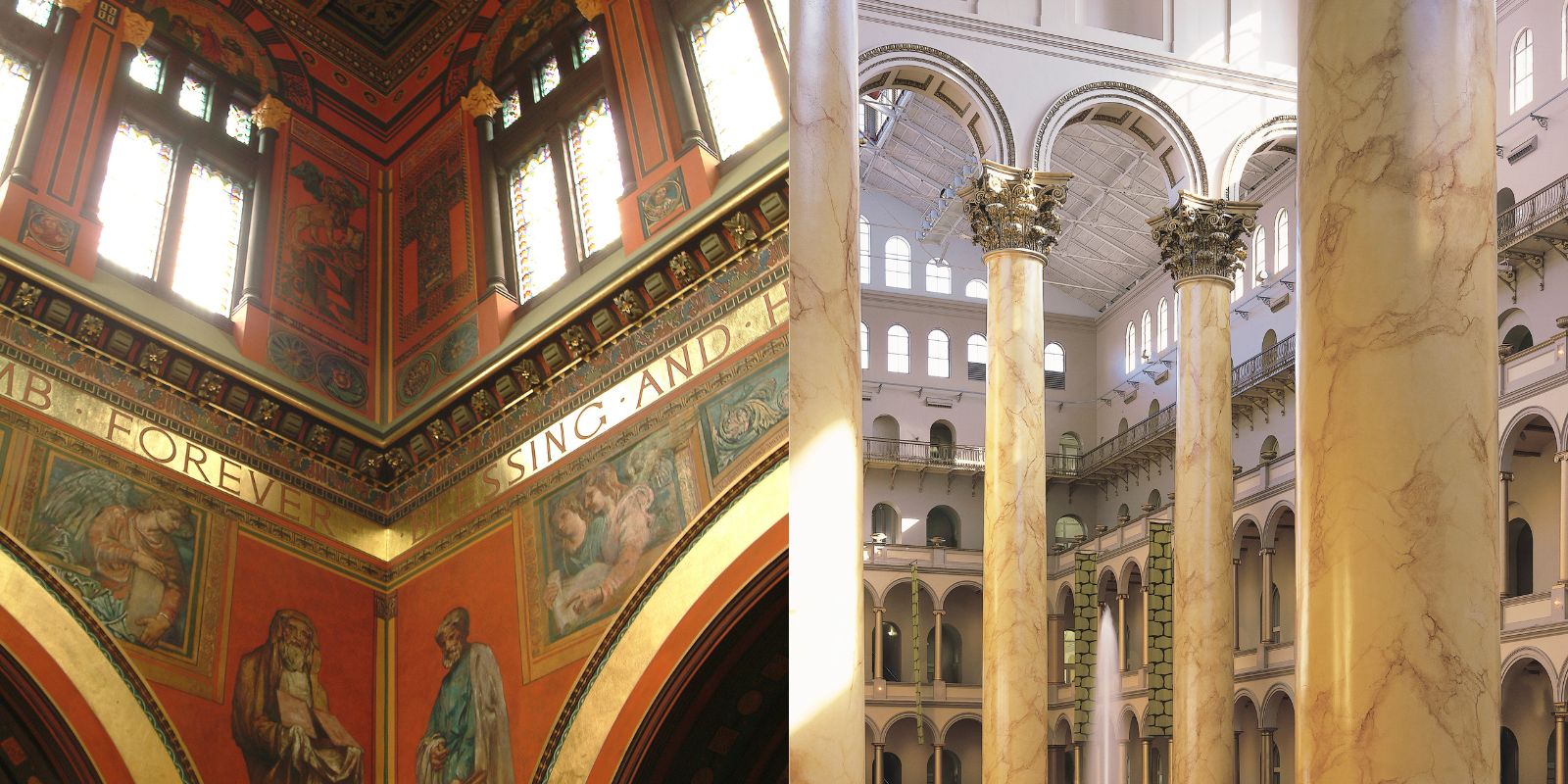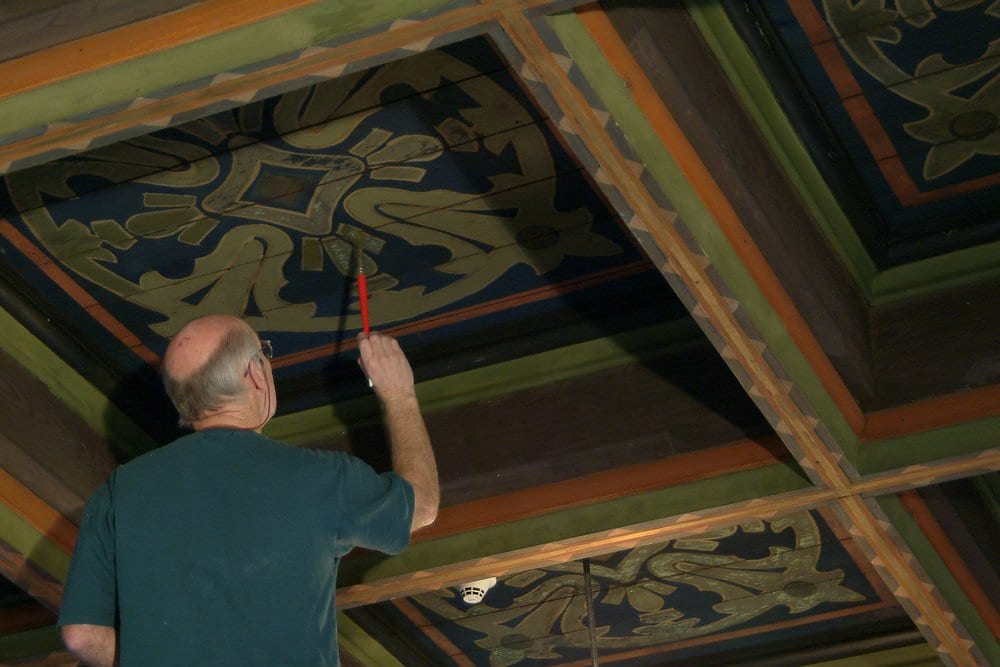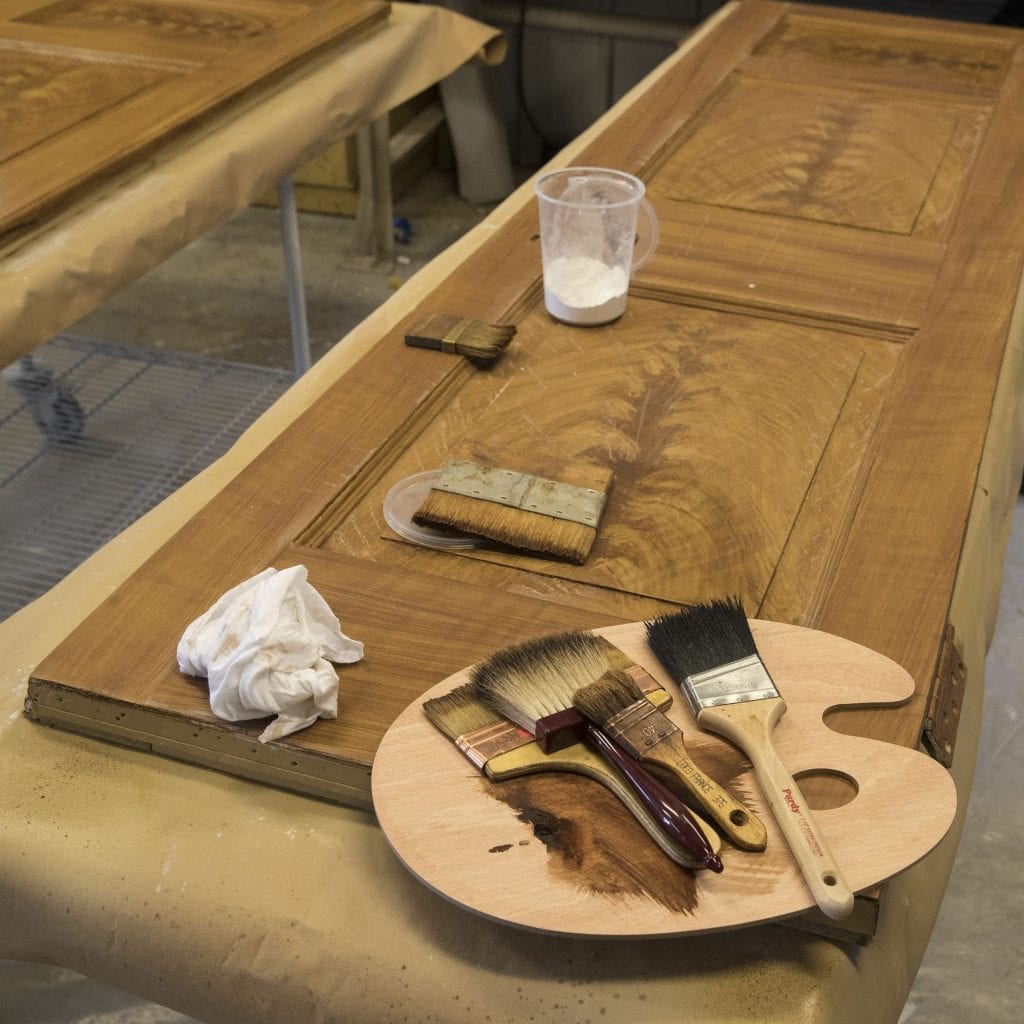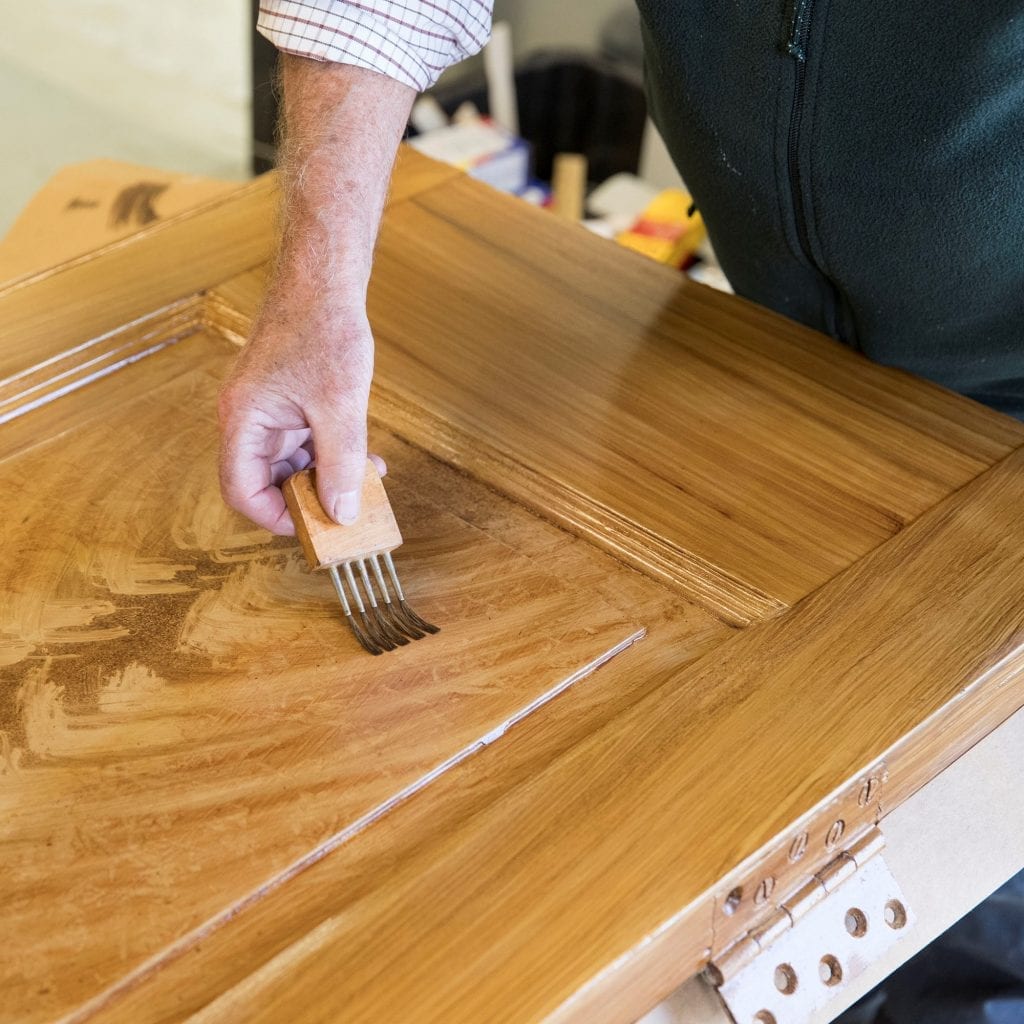Humans have employed decorative painting since at least the Stone Age. Today there are several decorative painting techniques, many of which are used in the architectural restoration, preservation, and conservation industry. These techniques create visual excitement and cohesive design through embellished surfaces of unique textures and finishes.
Canning regularly leverages these seven decorative painting techniques in American historic buildings:
1) Stenciling
Formed from paper, mylar, or lead foil, a stencil consists of a cut-out pattern or pierced design that is used to replicate a design or pattern. This decorative painting technique creates a superimposed painted image or pattern to reach specific areas determined by the stencil. Artwork in stencils can range from simple lettering and patterning to very ornate and complex designs. Stenciling is a practical technique for producing elegant designs to help reinstate and create decoration for historic buildings.
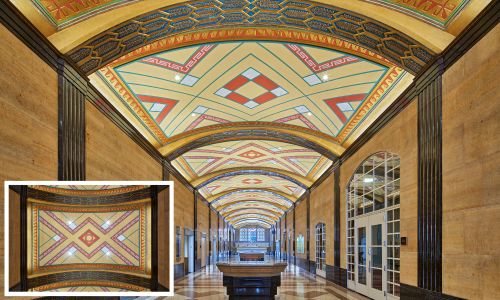
Theodore Levin Court House – Detroit, Michigan
2) Trompe L’oeil (aka Illusionistic Painting)
Typically, the use of decorative painting within historic building interiors is found on ceilings and walls. Many trompe l’oeil decorative designs are placed on ceilings to give a continued vertical appearance within a building. This illusionistic style draws the eye seemingly beyond the limits of the physical building. Trompe l’oeil, French for “trick the eye”, creates an illusion of depth and dimension through shadowing. Grisaille, a type of trompe l’oeil, uses a monochrome shading technique to create decorative effects.
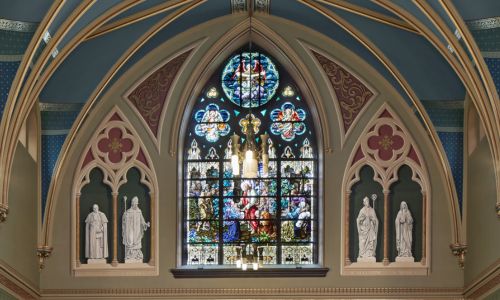
Basilica of St. John the Evangelist – Stamford, Connecticut
3) Striping
Whether part of an original design or integrated into a design project due to the undiscoverable historical paint, striping is a decorative painting technique where straight painted lines are laid using a beveled edge and rigid striping brush. These tools prevent raised edges and dripping, granting the artisan fluidity in making long, straight lines. When restoring the Central Tower within Trinity Church some decorative artwork was beyond conservation, so Canning reinstated it with stenciling, striping, lettering, and gold leafing.

Trinity Church – Boston, Massachusetts
4) Marbleizing
Commonly known as simulated stone, marbleizing is the decorative painting technique considered when original stone cannot be sourced due to cost, availability, or unsupported structural design within the building interior. This technique can be applied to a variety of substrates. During this multi-step process, a variety of finishes get applied to the substrate by a craftsperson educated in the nature of the stone to produce the desired results. Another faux marbling technique, scagliola is a complex process that is used to imitate marble through attentive craftsmanship and skill. An artisan can beautifully mimic the look of fine marble and stone by layering pigmented layers of plaster.
An example of the marbleizing technique can be seen in Canning’s work at the National Building Museum in Washington D.C. These 75-foot columns were built with 70,000 bricks, framed, and covered with smooth plaster and painted to resemble marble in 1895. After preparing mock-ups to develop color, vein and historic accuracy of the marble, Canning carried out a five-step process to marbleize these columns. The process included application of primer, application of a ground coat, application of a semitransparent glaze, large scale & detailed veining, and an application of semi-gloss varnish.

National Building Museum – Washington, D.C.
5) Glazing
This decorative paint technique not only helps preserve layers of paint, it allows for paint layers to radiate with more detail. The technique of glazing is used to deepen the pigment color creating warm or cool hues in a controlled application. This application can range from three to thirty coats depending on desired finish. A decorative technique of glazing called strié mimics aged paint altered by dust and sun, creating a stripe and plaid effect.
Another technique that uses both glazing and scumble is faux Gustavino tile. This tile system technique is formed by architecturally vaulted, self-supporting layers of terra cotta tile, mortared in a herringbone pattern. Scumble uses thinned opaque paints over an opaque paint basecoat to enhance aesthetic unity, using light and shade within a space. To achieve the faux Gustavino tile within projects like Boston Public Library, the tiles were finished with scumble, glaze, and crazing varnish.

Mohegan Sun Casino – Uncasville, Connecticut
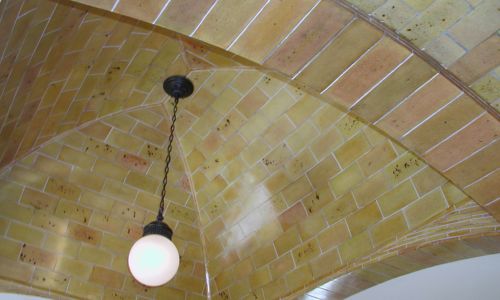
Boston Public Library – Boston, Massachusetts
6) Faux Bois / Woodgraining
This cost-effective decorative painting technique is most often used when species of wood cannot be sourced due to rarity, availability, or cost. This imitation of wood or wood grains can be applied to non-wood surfaces such as inexpensive woods, bricks, and brass. The woodgraining process involves many layers and techniques dependent on the desired wood grain outcome. Learn more about faux bois and the projects Canning has successfully crafted from our archives.

Michigan State Capitol – Lansing, Michigan
7) Simulated Mosaic
Some architectural designs use a multitude of decorative painting techniques in the process of restoration, conservation, and preservation. Simulated mosaic is skillfully crafted using paint shadowing to create an illusion of small stone pieces. This work is then finished using glazing, gilding, and stenciling to reach the desired outcome.

First Church of Christ Scientist – Boston, Massachusetts
Choosing the Correct Paint Technique
Before determining which decorative painting technique to use in a historic building restoration, preservation, or conservation opportunity, Canning performs a paint investigation inclusive of a historical paint analysis. Historical paint analyses can range from a single layer paint exposure to a multi-layer paint sample. Any form of paint removal should always be done by hand to mitigate risk of removing more than desired when determining the next steps in the restoration, preservation, or conservation opportunity. Paint exposures require very delicate handling as multiple historic paint designs may lie beneath. Paint exposures are used to reveal the hand of the artist and what decorative paint techniques might have been used. Collecting a paint sample entails removing multiple layers of paint including the substrate the paint has been applied to. These layers are then assessed under intense microscopy – optical, fluorescent, polarized – or spectrometry magnification to determine the different paint layers, pigments, and compounds within the historical paint. The paint analysis process involves historic materials archival research, on-site investigation, scientific analysis, and a final interpretation report.
Conclusion
Paint color is a simple, direct expression of specific time, taste, values, and mood. To consider paint only as a protective coating is to misunderstand its meaning as an important aspect of America’s heritage. Canning’s artisans have decades of collective experience and expertise to deliver the highest quality craftsmanship when it comes to decorative painting and finishes restoration. Through the use of traditional methods and materials, Canning is carrying forward the painting techniques of the past. Often building owners are unaware of the original decorative paint designs that exist within their structures until a historic paint and finishes analysis is completed. Plan the next restoration, preservation, conservation project with Canning. We pride ourselves on Perfecting Preservation.

